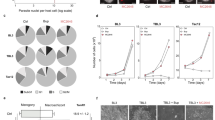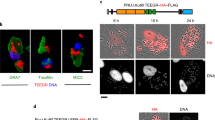Abstract
The function of the p53 protein as the central effector molecule of the p53 apoptotic pathway was investigated in a reversible model of epigenetic transformation. The infection of bovine leukocytes by the intracellular protozoan parasite Theileria annulata results in parasite-dependent transformation and proliferation of the host cells. We found p53 to be largely localized in the host cell cytoplasm and associated with the parasite membrane of isolated schizonts. Curing infected cells of the parasite with the theilericidal drug buparvaquone resulted in a time-dependent translocation of p53 into the host cell nucleus and the upregulation of the proapoptotic Bax and Apaf-1 and the downregulation of the anti-apoptotic Bcl-2 proteins. Although buparvaquone treatment led to apoptosis of the host cell, inhibition of either p53 or Bax significantly reduced buparvaquone-induced apoptosis of the transformed cells. Thus, the p53 apoptotic pathway of host cells is not induced by infection and transformation with Theileria by a mechanism involving cytoplasmic sequestration of p53. The close association of host cell p53 with the parasite membrane implies that the parasite either interacts directly with p53 or mediates cytoplasmic sequestration of p53 by interacting with other host cell proteins regulating p53 localization.
This is a preview of subscription content, access via your institution
Access options
Subscribe to this journal
Receive 50 print issues and online access
$259.00 per year
only $5.18 per issue
Buy this article
- Purchase on Springer Link
- Instant access to full article PDF
Prices may be subject to local taxes which are calculated during checkout





Similar content being viewed by others
References
Adams JM, Cory S . (2002). Apoptosomes: engines for caspase activation. Curr Opin Cell Biol 14: 715–720.
Ahmed JS, Rothert M, Steuber S, Schein E . (1989). In vitro proliferative and cytotoxic responses of PBL from Theileria annulata-immune cattle. Zentralbl Veterinarmed B 36: 584–592.
Ahmed JS, Schnittger L, Mehlhorn H . (1999). Theileria schizonts induce fundamental alterations in their host cells. Parasitol Res 85: 527–538.
Bakheit MA, Endl E, Ahmed JS, Seitzer U . (2006a). Purification of macroschizonts of a Sudanese isolate of Theileria lestoquardi (T. lestoquardi [Atbara]). Ann NY Acad Sci 1081: 453–462.
Bakheit MA, Scholzen T, Ahmed JS, Seitzer U . (2006b). Molecular characterization of a Theileria lestoquardi gene encoding for immunogenic protein splice variants. Parasitol Res 100: 161–170.
Bosari S, Viale G, Roncalli M, Graziani D, Borsani G, Lee AK et al. (1995). p53 gene mutations, p53 protein accumulation and compartmentalization in colorectal adenocarcinoma. Am J Pathol 147: 790–798.
Boyd JM, Malstrom S, Subramanian T, Venkatesh LK, Schaeper U, Elangovan B et al. (1994). Adenovirus E1B 19 kDa and Bcl-2 proteins interact with a common set of cellular proteins. Cell 79: 341–351.
Dobbelaere DA, Prospero TD, Roditi IJ, Eichhorn M, Williams RO . (1988). Theileria parva infection induce autocrine growth of bovine lymphocytes. Proc Natl Acad Sci USA 85: 4730–4734.
Fortin A, Cregan SP, MacLaurin JG, Kushwaha N, Hickman ES, Thompson CS et al. (2001). APAF1 is a key transcriptional target for p53 in the regulation of neuronal cell death. J Cell Biol 155: 207–216.
Galley Y, Hagens G, Glaser I, Davis W, Eichhorn M, Dobbelaere D . (1997). Jun NH2-terminal kinase is constitutively activated in T cells transformed by the intracellular parasite Theileria parva. Proc Natl Acad Sci USA 94: 5119–5124.
Gardner MJ, Bishop R, Shah T, de Villiers EP, Carlton JM, Hall N et al. (2005). Genome sequence of Theileria parva, a bovine pathogen that transforms lymphocytes. Science 309: 134–137.
Guergnon J, Dessauge F, Langsley G, Garcia A . (2003). Apoptosis of Theileria-infected lymphocytes induced upon parasite death involves activation of caspases 9 and 3. Biochemie 85: 771–776.
Heussler VT, Kuenzi P, Fraga F, Schwab RA, Hemmings BA, Dobbelaere DA . (2001). The Akt/PKB pathway is constitutively activated in Theileria-transformed leucocytes, but does not directly control constitutive NF-kappaB activation. Cell Microbiol 3: 537–550.
Heussler VT, Rottenberg S, Schwab R, Küenzi P, Fernandez PC, McKellar S et al. (2002). Hijacking of host cell IKK signalosomes by the transforming parasite Theileria. Science 298: 1033–1036.
Knippschild U, Oren M, Deppert W . (1996). Abrogation of wild-type p53 mediated growth-inhibition by nuclear exclusion. Oncogene 12: 1755–1765.
Lane DP, Crawford LV . (1979). T antigen is bound to a host protein in SV40-transformed cells. Nature 278: 261–263.
Levine AJ . (1997). p53, the cellular gatekeeper for growth and division. Cell 88: 323–331.
Liang SH, Clarke MF . (2001). Regulation of p53 localization. Eur J Biochem 268: 2779–2783.
McHardy N, Morgan DW . (1985). Treatment of Theileria annulata infection in calves with parvaquone. Res Vet Sci 39: 1–4.
McHardy N, Wekesa LS . (1985). In: Irvin AD (ed). Buparvaquone BW 720C: a new antitheilerial napthoquinone—its role in the therapy and prophylaxis of theileriosis. Immunization Against Theileriosis in Africa. International Laboratory for Research on Animal Diseases: Nairobi, Kenya. pp 88.
Miyashita T, Reed JC . (1995). Tumor suppressor p53 is a direct transcriptional activator of the human bax gene. Cell 80: 293–299.
Moll UM, LaQuaglia M, Benard J, Riou G . (1995). Wild-type p53 protein undergoes cytoplasmic sequestration in undifferentiated neuroblastomas but not in differentiated tumors. Proc Natl Acad Sci USA 92: 4407–4411.
Moll UM, Ostermeyer AG, Haladay R, Winkfield B, Frazier M, Zambetti G . (1996). Cytoplasmic sequestration of wild-type p53 protein impairs the G1 checkpoint after DNA damage. Mol Cell Biol 16: 1126–1137.
Moll UM, Riou G, Levine AJ . (1992). Two distinct mechanisms alter p53 in breast cancer: mutation and nuclear exclusion. Proc Natl Acad Sci USA 89: 7262–7266.
Nikolaev AY, Li M, Puskas N, Qin J, Gu W . (2003). Parc: a cytoplasmic anchor for p53. Cell 112: 29–40.
O'Brate A, Giannakakou P . (2003). The importance of p53 location: nuclear or cytoplasmic zip code? Drug Resist Updat 6: 313–322.
Oliner JD, Pietenpol JA, Thiagalingam S, Gyuris J, Kinzler KW, Vogelstein B . (1993). Oncoprotein MDM2 conceals the activation domain of tumour suppressor p53. Nature 362: 857–860.
Pain A, Renauld H, Berriman M, Murphy L, Yeats CA, Weir W et al. (2005). Genome of the host-cell transforming parasite Theileria annulata compared with T. parva. Science 309: 131–133.
Scheffner M, Werness BA, Huibregtse JM, Levine AJ, Howley PM . (1990). The E6 oncoprotein encoded by human papillomavirus types 16 and 18 promotes the degradation of p53. Cell 63: 1129–1136.
Schlamp CL, Poulsen GL, Nork TM, Nickells RW . (1997). Nuclear exclusion of wild-type p53 in immortalized human retinoblastoma cells. J Natl Cancer Inst 89: 1530–1536.
Schneider I, Haller D, Seitzer U, Beyer D, Ahmed JS . (2004). Molecular genetic characterization and subcellular localization of a putative Theileria annulata membrane protein. Parasitol Res 94: 405–415.
Seitzer U, Schnittger L, Boguslawski K, Ahmed JS . (2006). Investigation of MAP kinase activation in Theileria-infected cell lines. Ann NY Acad Sci 1081: 473–475.
Shayan P, Gerlach C, Hügel FU, Kay G, Campbell JD, Gerdes J et al. (1999). The proliferation-associated nuclear protein Ki-67 in the bovine system: partial characterisation and its application for determination of the proliferation of Theileria-infected bovine cells. Parasitol Res 85: 613–620.
Shimizu S, Narita M, Tsujimoto Y . (1999). Bcl-2 family proteins regulate the release of apoptogenic cytochrome c by the mitochondrial channel VDAC. Nature 399: 483–487.
Sun XF, Carstensen JM, Zhang H, Stal O, Wingren S, Hatschek T et al. (1992). Prognostic significance of cytoplasmic p53 oncoprotein in colorectal adenocarcinoma. Lancet 340: 1369–1373.
Toye P, Nyanjui J, Goddeeris B, Musoke AJ . (1996). Identification of neutralization and diagnostic epitopes on PIM, the polymorphic immunodominant molecule of Theileria parva. Infect Immun 64: 1832–1838.
Ueda H, Ullrich SJ, Gangemi JD, Kappel CA, Ngo L, Feitelson MA et al. (1995). Functional inactivation but not structural mutation of p53 causes liver cancer. Nat Genet 9: 41–47.
Vogelstein B, Lane D, Levine AJ . (2000). Surfing the p53 network. Nature 408: 307–310.
Wu Y, Mehew JW, Heckman CA, Arcinas M, Boxer LM . (2001). Negative regulation of bcl-2 expression by p53 in hematopoietic cells. Oncogene 20: 240–251.
Acknowledgements
This work was supported in part by a grant from the European Commission INCO-DEV Program (Contract Grant Number: ICA4-CT-2000-30028).
Author information
Authors and Affiliations
Corresponding author
Ethics declarations
Competing interests
The authors declare no conflict of interest.
Additional information
Supplementary Information accompanies the paper on the Oncogene website
Rights and permissions
About this article
Cite this article
Haller, D., Mackiewicz, M., Gerber, S. et al. Cytoplasmic sequestration of p53 promotes survival in leukocytes transformed by Theileria. Oncogene 29, 3079–3086 (2010). https://doi.org/10.1038/onc.2010.61
Received:
Revised:
Accepted:
Published:
Issue Date:
DOI: https://doi.org/10.1038/onc.2010.61
Keywords
This article is cited by
-
Trypanosoma cruzi infection induces DNA double-strand breaks and activates DNA damage response pathway in host epithelial cells
Scientific Reports (2024)
-
Artemisinin derivatives induce oxidative stress leading to DNA damage and caspase-mediated apoptosis in Theileria annulata-transformed cells
Cell Communication and Signaling (2023)
-
Theileria annulata SVSP455 interacts with host HSP60
Parasites & Vectors (2022)
-
Modulation of p53 during bacterial infections
Nature Reviews Microbiology (2015)
-
Schizonts of Theileria annulata interact with the microtubuli network of their host cell via the membrane protein TaSP
Parasitology Research (2010)



